How To Split Firewood With A Hatchet For Beginners
- December 19, 2023
- 1 comment
Throughout my years as a camp counselor, lead resident camp counselor and adventure trip leader, I gradually adjusted the gear I carried in my backpack for day-to-day activities. Among all the items in my bag, my hatchet was undoubtedly the most frequently used.
Whether I was swiftly fashioning a makeshift tomahawk handle to replace one broken by campers, refining a rough spot on a log bench, or tasked with starting a fire promptly in pouring rain, that hatchet proved indispensable.

One of its most common uses was undoubtedly splitting wood, from large rounds into quarters to breaking quarters down into kindling.
While a hefty splitting maul or axe relies on the weight of its head to power through logs, splitting firewood with a hatchet demands precision, a few finesse techniques, careful log selection, and an understanding of the hatchet’s limitations.
Why Use a Hatchet for Wood Splitting
Splitting wood enhances immediate combustion by creating sharper angles with more exposed wood, thereby opening up the resin-rich heartwood to flames. For a more in-depth exploration of the scientific aspects behind the question “Why do we Split Firewood?” check out my comprehensive article.

Optimized for the task of splitting firewood, splitting mauls feature a large, heavy, and aggressively wedge-shaped head with long handles designed to efficiently tear logs apart. When splitting wood at home, on the farm, or at a fixed basecamp, a splitting maul is the ideal tool.
Consider obtaining one from your local hardware store, with a preference for a wooden handle if you plan on extensive splitting to avoid blisters (as rubbery handles are more likely to cause them). For those seeking a top-notch axe, the Hultafors 30in Splitting Axe (imported by Husqvarna and branded in the US) is a great choice.
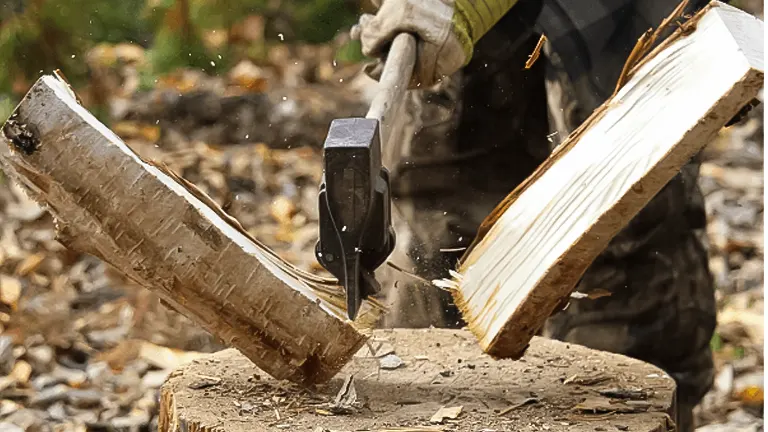
However, in camping or hiking scenarios, lugging around a large splitting maul may not be practical. My compact hatchet was a constant companion in my backpack during various camping trips, frequently used to split full logs into quarters or further down into kindling.
Especially during backpacking trips, minimizing weight is crucial. While a hefty maul excels at wood splitting, its weight is impractical for backcountry travel, and its specialization limits its versatility. Hatchets, on the other hand, serve as more versatile tools, capable of cutting deep enough to fell moderate trees, sharp enough for feathering sticks, and sturdy enough for wood splitting.
Techniques for Splitting Wood with a Hatchet
If you prefer a visual guide, you can check out my video demonstrating the process of splitting firewood with a hatchet:
With a substantial maul, it becomes convenient to depend on the gravitational force of the head to effortlessly cleave through even the most obstinate, contorted logs. In contrast, the finesse required for wood splitting with a hatchet demands a more skillful and deliberate approach.
Before embarking on any outdoor adventures, dedicating some time to honing your accuracy with the hatchet in the controlled environment of your home is highly recommended. Practice sessions will not only enhance your skill but also instill confidence in handling the tool effectively when out on the trail.
During my initial stages of learning to wield a hatchet, my camp director recognized the importance of accuracy and set me on a task of creating a substantial store of kindling. Observing my initial struggles, he wisely advised me to focus on improving my precision to consistently hit my intended target.
To facilitate this practice, my camp director ingeniously utilized a box of wooden matches. He made a shallow cut in the top face of the log awaiting splitting and inserted a matchstick into it. The challenge was clear: split ten matchsticks in half with precision before progressing to the more intricate task of splitting the matchstick and the log below with a single, well-aimed blow.
The Versatile Hatchet
In the world of outdoor exploration, my trusty hatchet has become an indispensable companion, proving its worth far beyond its conventional role as a cutting tool. Whether faced with the challenge of crafting a makeshift handle or refining the surface of a log bench, my hatchet has consistently risen to the occasion, showcasing its versatility.
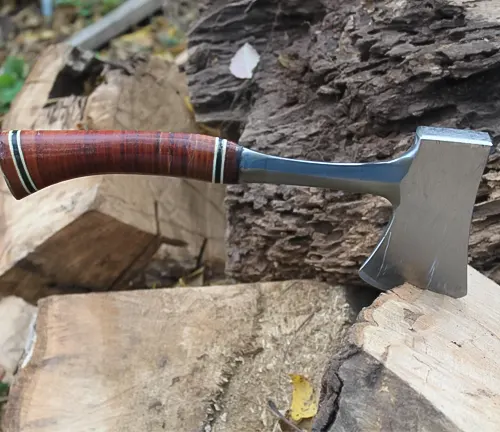
What sets it apart is its adaptability to various tasks, making it a tool of choice for a range of situations. Amidst the rugged terrain and unpredictable demands of the outdoors, the hatchet has become a reliable partner, ready to tackle whatever challenges come its way. However, it’s in the realm of wood splitting that the hatchet truly excels, showcasing its prowess in transforming large logs into manageable pieces for various purposes.
Accuracy Over Brawn
While a hefty splitting maul or axe may rely on sheer force to cleave through logs, the hatchet demands a different approach—one characterized by precision and finesse. It’s a tool that requires a deep understanding of the wood’s grain, the hatchet’s design, and the art of well-timed swings. Unlike the brute strength needed for larger tools, the hatchet calls for a nuanced skill set, emphasizing accuracy over raw power.
Wood splitting with a hatchet is a dance, a delicate choreography of controlled strength and finesse techniques. The wielder must carefully select logs that complement the hatchet’s design, ensuring a symbiotic relationship between tool and task. In this way, the hatchet transforms wood splitting from a mere chore into a skillful and gratifying endeavor, where every swing is a calculated step towards achieving the desired result.

Selecting the Ideal Log for Splitting
Discerning the right type of log for splitting is a crucial aspect of mastering the art of hatchet wood splitting. Not all logs are created equal, and choosing the appropriate one can significantly impact the efficiency of the process, especially for those new to the task.
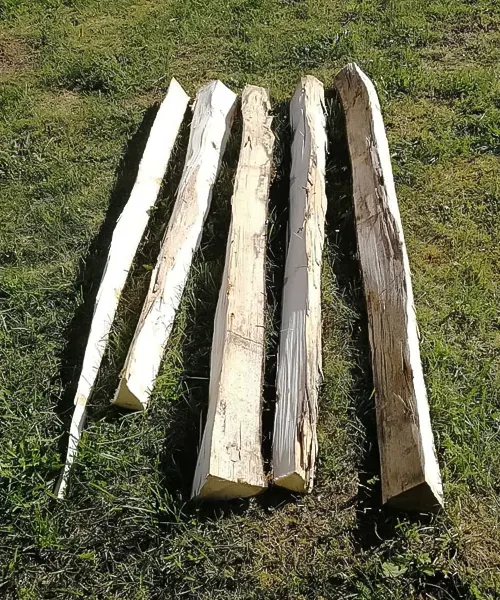
In the initial stages, opt for logs composed of less dense wood with a straight grain and devoid of knots. This selection ensures a more manageable starting point for beginners. As proficiency grows, one can gradually progress to more challenging logs, but it’s essential to recognize that certain logs pose a formidable challenge even for a well-handled hatchet.
Tackling green, aged, and gnarled oak logs, for instance, proves to be particularly demanding, pushing the limits of any wood-splitting tool, especially a smaller hatchet. The moisture content of the log also plays a crucial role; drier logs are inherently easier to split. Therefore, seasoned wood is preferable for a smoother splitting experience. Less dense woods such as birch, cedar, or pine are inherently more brittle, rendering them easier to split.
Additionally, the nature of the wood’s grain and the absence of knots significantly influence the ease of splitting. Opting for straight-grained wood without knots not only facilitates the process but also reduces the likelihood of complications. Furthermore, considering the length of the logs is crucial; shorter logs present less surface area to separate compared to their longer counterparts, affecting the overall ease of the splitting endeavor.
Traditional Stump Splitting Technique
Similar to using an axe or maul, employing a hatchet for splitting wood is most effective when done on a flat and stable surface, alleviating concerns about the blade getting stuck during the process.
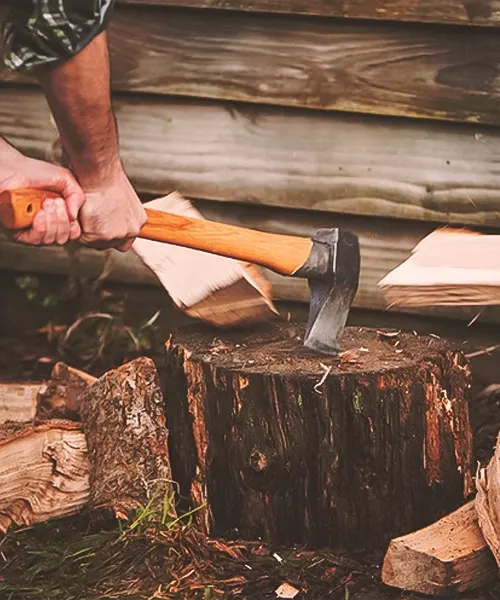
Due to the hatchet’s shorter handle, it is advisable to use a splitting stump that is slightly taller, positioned closer to waist height rather than the knee-high stumps typically paired with longer axes. The choice of a taller stump ensures a more ergonomic and efficient splitting experience with the hatchet.
In contrast to the swinging motion of a maul, splitting with a hatchet requires a more dynamic involvement of the entire body. Begin by placing a log securely on the stump, adjusting its position until it finds a stable equilibrium. Grasp the hatchet handle with one or both hands, lift it overhead, and deliver a forceful downward swing.
When aiming, it is crucial to target the bottom of the log being split rather than the top. While it may seem inconsequential, aiming for the bottom prevents the subconscious deceleration of the hatchet as it contacts the top surface. The goal is to direct the hatchet through the log, not toward its upper section.
Given the nature of this technique, there is a likelihood that the hatchet blade may become lodged midway through a challenging log. This possibility highlights the importance of familiarizing oneself with additional techniques to overcome such obstacles effectively.
The Upright Bash Technique
While lacking a formalized name, the “Upright Bash” technique is aptly descriptive, serving as a valuable method when your hatchet blade becomes lodged in a log during a splitting attempt, whether inadvertently or intentionally.
When faced with a hatchet blade firmly embedded in a log, execute the “Upright Bash” by gripping the handle with both hands and lifting both the log and hatchet together. Elevate them high, maintaining the log in a vertical orientation, and forcefully bring them down onto the splitting stump as though attempting to bash the log into it.
This particular technique proves especially beneficial when dealing with challenging wood grain patterns or stubborn knots. Its utility extends to fine splitting, particularly when working on kindling. Narrow splits can be challenging to keep standing independently and may be difficult to accurately strike. In such cases, cautiously hold the small split intended for further division in an upright position.
Carefully tap the hatchet blade onto the top surface until it securely lodges. Lift both the split and the hatchet together, and execute a forceful downward bash to complete the kindling-splitting process.
Batonning with a Hatchet
Choosing a safer and more strategic approach compared to risking your hands, batonning hatchets offers an excellent method for splitting fine kindling.
Unlike the divisive discussions surrounding batonning knives, batonning hatchets are generally accepted. Hatchets, being striking tools made of tough, impact-resistant steels, are specifically designed to endure rigorous use.
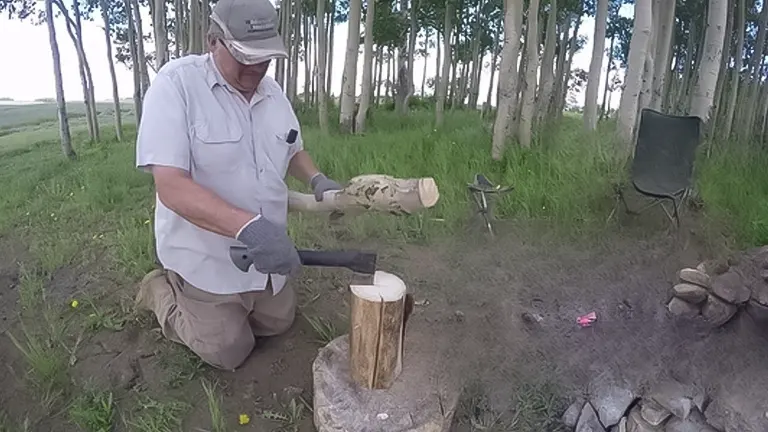
To baton with a hatchet, position your log or split upright and place the hatchet head where you intend to split. Apply a slight downward pressure with the hatchet to secure everything in place. Take a stick or log of approximately wrist thickness and strike the back of the hatchet head to drive it into the wood, acting like a wedge.
While you may not fully penetrate the wood before burying the blade, you can safely conclude the task using the upright bash technique at this point.
Caution should be exercised to avoid striking hardenable steel against hardenable steel (e.g., axe on hatchet, hammer on hatchet), as this can result in the hatchet shattering in a hazardous manner. It’s important to note that splitting wedges are intentionally crafted from softer steel for safety reasons in such scenarios.
Additionally, it is advised not to beat on the hatchet handle. Once the head is embedded, transition to bashing the log and hatchet together onto your stump to complete the splitting process.
Parallel Wood Splitting
For logs with a diameter of up to approximately four inches (dependent on factors such as species and knots), an alternative method for splitting emerges—the parallel split.

This technique proves advantageous when a dedicated splitting stump is unavailable, as you can utilize roots, fallen logs, or any reasonably resilient surface as a backing plate. Begin by grasping the near end of the wood to be split with your non-dominant hand. Align your hatchet handle parallel to the wood, positioning the blade a few inches from the far end. Swing the two together into your stump, allowing the blade to cut through the wood laterally.
Exercise caution to prevent pinching your fingers between the wood and the hatchet handle. Anticipate that the two components may attempt to pivot relative to each other, and be prepared to counteract this movement.
Once the hatchet head is embedded, maneuver the two pieces sideways about each other, aiming to split the wood as the blade twists within it. It may be necessary to work the blade free, and then reverse the wood, repeating the process on the opposite end.
Concluding Thoughts
If you’re interested in delving deeper into the characteristics that define a hatchet or seeking a concise buyer’s guide for hatchets, I invite you to explore my comprehensive article titled “What is a Hatchet.”
In that article, I provide recommendations for two hatchets that I endorse. The first is the Hults Bruk Almike, which I use, although it comes with a slightly higher price tag. Alternatively, the Hultafors 13in Hatchet Imported by Husqvarna is another excellent option—a bit weightier but considerably more budget-friendly.
Frequently Asked Questions
- What type of wood is best for beginners to practice splitting with a hatchet?
Start with softer woods like pine, cedar, or birch. These woods are less dense and generally easier to split, allowing beginners to develop their skills before tackling harder woods like oak or hickory. - How do I choose the right size and weight of a hatchet for firewood splitting as a beginner?
For beginners, a hatchet with a medium weight (around 1.5 to 2.5 pounds) and a manageable handle length is ideal. This balance provides enough force without causing excessive strain. Consider your strength and comfort when selecting a hatchet. - What safety precautions should I take when splitting firewood with a hatchet?
Safety is paramount. Wear protective gear, including safety glasses and gloves. Ensure a clear and stable work area. Always split on a solid surface like a chopping block, and make sure bystanders are at a safe distance. Additionally, maintain a secure grip on the hatchet to avoid accidental slips. - Are there specific techniques to improve accuracy and efficiency in hatchet wood splitting?
Yes, accuracy is crucial. Practice your swing to hit the same spot consistently. Aim for the center of the log and adjust your grip as needed. Develop finesse techniques, like using controlled hip and shoulder movements, to generate power in your swing. - Can I split larger logs with a hatchet, or is it only suitable for smaller pieces?
While a hatchet is generally better for smaller pieces and kindling, you can split larger logs with the right technique. Consider using a method like batoning or the upright bash for larger logs, and gradually work your way up as you gain experience. - How do I care for my hatchet to ensure longevity and optimal performance?
Regular maintenance is essential. Keep the blade sharp using a file or sharpening stone. Check the handle for any signs of damage or wear, and replace it if necessary. Store your hatchet in a dry place to prevent rust, and oil the blade periodically for added protection. Proper care ensures your hatchet remains a reliable tool over time.
Your voice matters! Whether you’re a novice or have some seasoned tips under your belt, share your triumphs and challenges in the art of hatchet wood splitting. Your firsthand experiences are a goldmine for beginners, providing them with valuable insights to navigate their wood-splitting adventures. Join the conversation in the comments section and let’s build a community where everyone’s journey is heard and celebrated!

Edward Smith
Forestry AuthorWoodworking is about more than crafting; it's a harmonious connection with nature, mastering tools, and preserving our environment. I'm here to share my knowledge and experiences with you, forging a future where we can embrace wood's beauty and utility while safeguarding our forests' health and diversity.





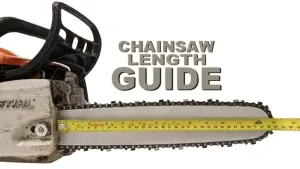



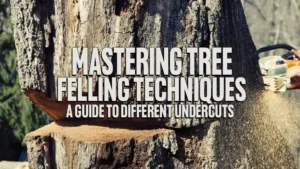
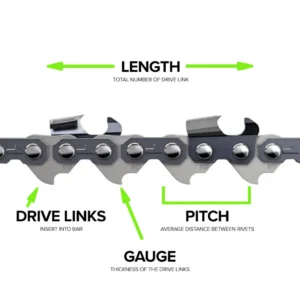

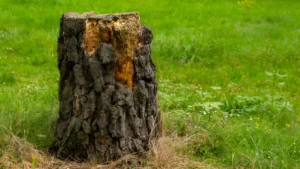
Iam not a writer or a very good speller for that mater but I have cut roughly 1000 cords of wood a d split them all by hand u have had many opryunitus to buy a wood spliter but I passed because I enjoy splitting wood I can split a cord of wood by myself faster than any man can buy himself with a wood spliter I mainly cut lodgpole dougfir cedar and oak and pitch wood. I found this article interesting. There is nothing like experience a few tips I would have would be if you can't split your log try moving to another spot to hit it or flip the round over Don't peck at the wood loke a wood pecker take big swings hold the mall at the end like a bat learnt to wi drill your mall like driving a spike on the rail road that's wear I lend my tecnike.dont use your axes as siting wedges or you will break them even the exspicve ones like fiskers will break if you strike the back .nice dry insence cedar makes great kindling you can make a lot of nice kindling with good cedar I give boxes of kindling away to my newborn hear near Mt Shasta ca.be carefully and w a tch your fingers .
Charles Adams
December 27, 2023 6:15 am